Menu
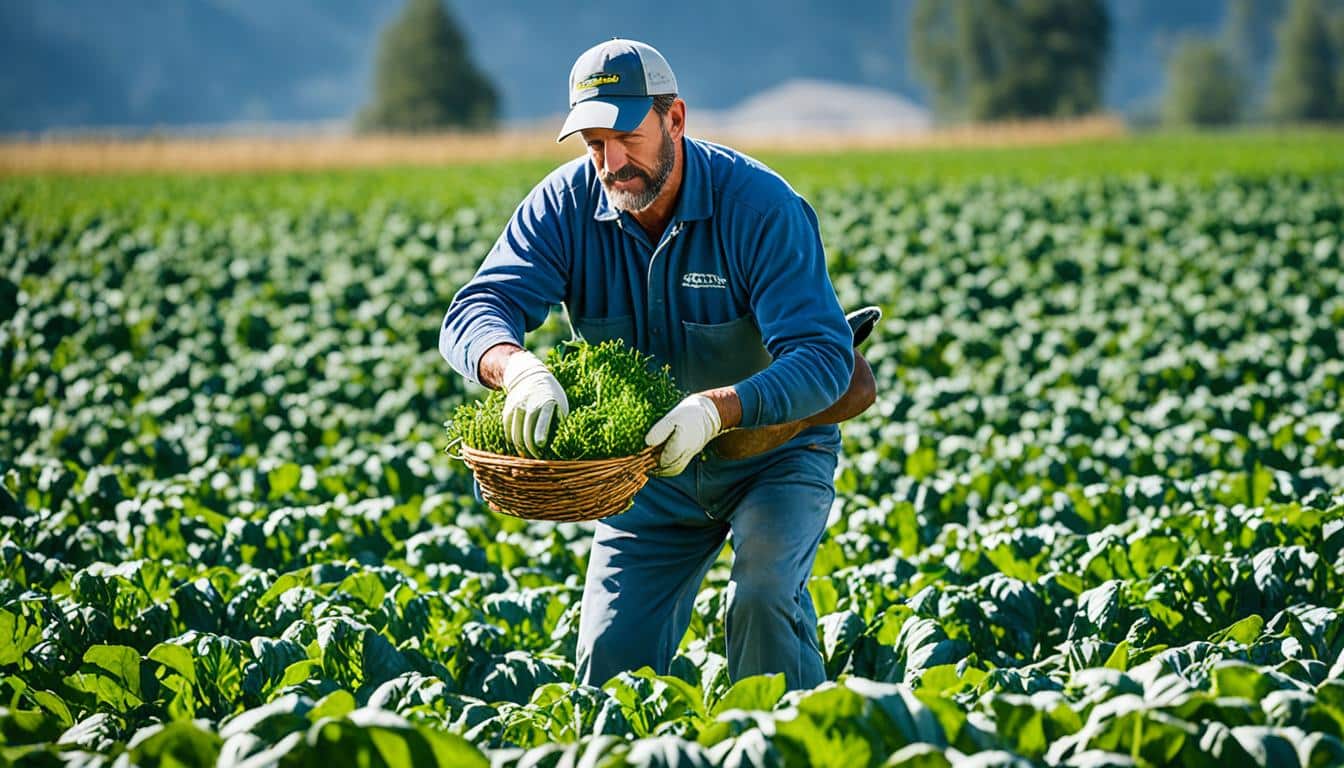
Is your push to gather crops quickly putting you in danger? During the autumn harvest, farmers sometimes forget safety. This can lead to more risks of being hurt or even killed. The short days and falling temperatures make things harder for farmers, increasing the chances of accidents.
Using safe methods in harvesting is key, not just for following rules but to keep everyone safe and manage crops well. It’s staggering to learn that getting caught in machines causes most farm injuries and deaths. This calls for a strong focus on following safety advice closely.
Taking needed breaks and getting trained right are good ways to lower risks. It’s also crucial to keep up with changes in how we light and mark our machinery. These rules have been updated in 2015 and need to be followed.
Planning for emergencies, checking machine guards, and keeping grain bins safe are vital steps. These ensure a harvest period that’s both safe and successful. By giving attention to these areas, we protect workers and the harvest itself.
During the fall, farmers often move quickly to get their crops in. This can lead to accidents. That’s why getting ready before the harvest season starts is crucial. Planning well helps to make things safer for everyone.
Making a checklist for farm safety is key. Cheryl Skjolaas from the UW Center says it’s important. She suggests a detailed list for the whole family. This helps to make sure everyone knows how to stay safe. It builds a safety-first attitude where everyone plays their part.
Looking after farm machinery and the surroundings is important. It cuts down on breakdowns and short cuts that can be dangerous. Regular checks and keeping things tidy prevents problems. This keeps the farm running smoothly and safely.
Giving out jobs for maintenance to workers or family members is a smart move. It helps to keep everything running well during the harvest time. This is a big part of a solid farm safety plan.
“Pre-planning for the harvest season is crucial in preventing accidents and injuries when facing busy days.” – Cheryl Skjolaas
Here’s a quick look at why planning is better than the risks of not doing it:
| Pre-planning Benefits | Risks of Neglect |
|---|---|
| Injury prevention | Increased risk of accidents |
| Better equipment performance | Frequent breakdowns |
| Organisational efficiency | Disorganised workflows |
| Enhanced safety compliance | Potential legal issues |
The off-season is a great time for both new and experienced farm workers to look again at machinery manuals. It’s key to understand how these machines work. This knowledge keeps the work area safe and helps you do a good job.
Safety expert Cheryl Skjolaas says knowing machinery manuals well is very important. This is especially true for machines that have sat idle for a while. When you know the details of a machine, you can spot and fix problems early. This stops accidents and makes work smoother.
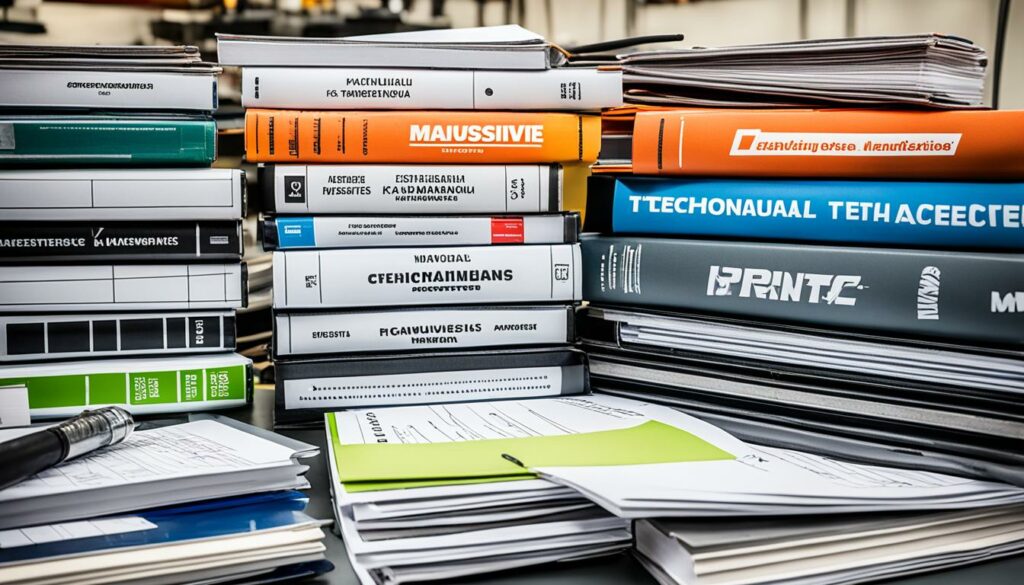
These months are perfect for getting ready. Spend time going through these manuals. This not only makes you better at using the machines, but it also makes accidents less likely. Accidents with machines are serious and can cause harm. So, knowing your machine well is a big part of staying safe on the farm.
Also, it’s vital to keep up with any new rules or changes. Experts might change what they recommend for machine lights, for example. Keeping up with these updates is crucial for being safe, especially during harvest.
Knowing your machine can help with emergency plans too. It’s wise to train everyone on how to use farm machines safely. This lowers the chance of accidents. Reading through the manuals in the off-season is not just about getting more work done. It’s about keeping the farm a safe place.
Creating a good emergency communication plan is key for farm safety. It helps everyone act fast during crises like natural disasters or chemical threats. A well-thought-out plan lets every team member know what to do quickly, especially to keep animals safe.
Keeping a list of emergency contacts is vital. This list should include people who can make decisions if someone is not available. For livestock, this is critical for daily needs like feeding and proper air if the main decision-maker is away.
Response protocols are essential in any communication plan. They involve all team members in different roles, ensuring they know what to do. This means being prepared with necessary items like food and vet supplies, having a list of what’s needed in an emergency, and training on how to use important machinery.
“Covello and Allen’s (1988) cardinal rules on effective communication in crisis situations highlight the significance of transparency, audience involvement, and honesty,” remarked Agricultural Safety Specialist Cheryl Skjolaas.
Having a clear plan and practicing it regularly is vital. It helps you see if your plan really works and avoids chaos in real emergencies. A good plan strengthens everyone’s knowledge and their ability to react fast during difficult times.
Well-prepared emergency preparedness plans ensure a strong response. This not only keeps people and livestock safe but also boosts the productivity and safety of the farm.
Keeping the yard safe is key for managing the farming area. This helps prevent accidents when harvesting. By cutting low tree branches and fixing electrical dangers, we can avoid many safety risks.
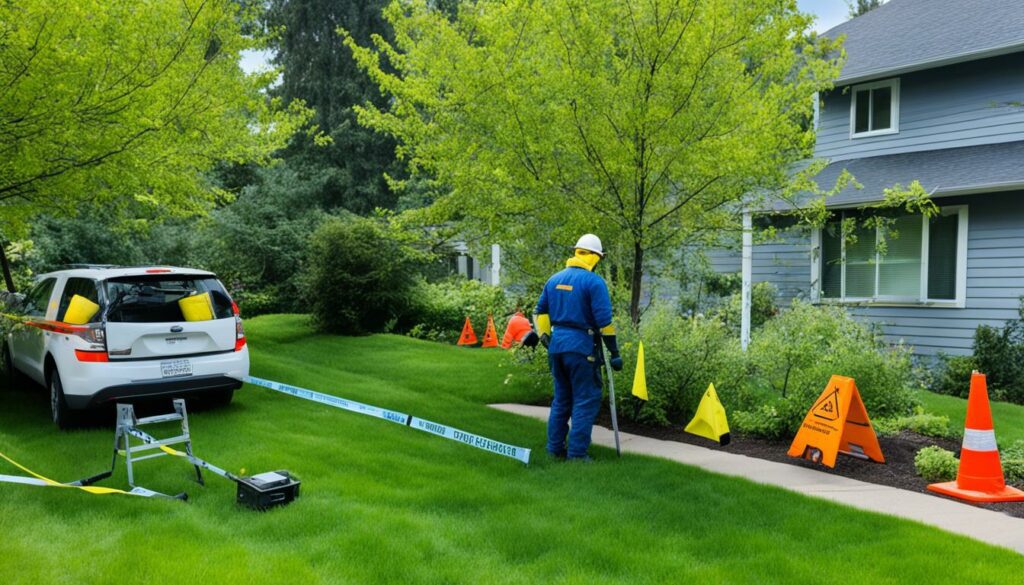
Low tree limbs are risky for farm workers and equipment. Regular trimming makes it safer for machines to move around. It also stops people from getting hurt. So, taking care of the yard makes farming work better and safer.
Electric dangers are a big worry on farms. Talking to electric companies helps you know and deal with these risks, especially before heavy rains. Making sure all equipment is safe can stop serious accidents.
The table below shows the important steps to take for yard safety:
| Action | Reason | Frequency |
|---|---|---|
| Trim Low-Hanging Limbs | Prevent accidents and make it easier for machines to move | Monthly |
| Inspect Electrical Equipment | Find and fix electric dangers | Bi-weekly |
| Coordinate with Electrical Companies | Deal with risks before heavy rains | Once a year or as needed |
Handling these yard safety steps helps us create a safer, more productive farm. Preventing accidents is crucial for a successful and safe harvest.
The need for thorough agricultural training in equipment safety education is crucial. About 15% of farm machinery accidents occur during harvest. They are mainly due to mistakes and a lack of knowledge. Stats from the National Safety Council support this, with over 14% of accidents happening in 1982 during harvesting.
Getting stuck into fixing machines while they’re running is an extremely dangerous job. It can lead to serious injuries, even amputations. It’s vital that operators read the manual for each machine before the harvest. This gives important advice on using and looking after the equipment safely. Keeping machines in tip-top shape helps avoid accidents and makes the farm run better.
Farm competency means more than just knowing how to use machines. It includes wearing the right protective gear to stay safe. Workers must take breaks to stay sharp and not too tired, which helps avoid accidents. If they’re using a tractor with a Roll-Over Protection Structure (ROPS), wearing a seat belt is essential. Experts say a belt can save your life.
Surprisingly, some farmers still use old machines that lack safety features like ROPS. This shows why we must keep on training to meet the latest safety standards. I believe all workers, especially the young ones, need to be well-trained. Training should focus on how to lift things properly and smarter ways to move between tasks on the farm.
On top of everything else, being careful on the roads is a must, especially during busy times in the morning and later in the day. The work of 40 Square Cooperative Solutions to promote safe harvest practices is very important. It highlights the critical role of agricultural training in having a safe and successful harvest time.
Keeping children’s farm safety in check is crucial to stop tragic accidents. Farms can be very risky for kids. It’s very important to set up safe areas for them and make sure they follow safety rules. This is the best way to keep them safe.
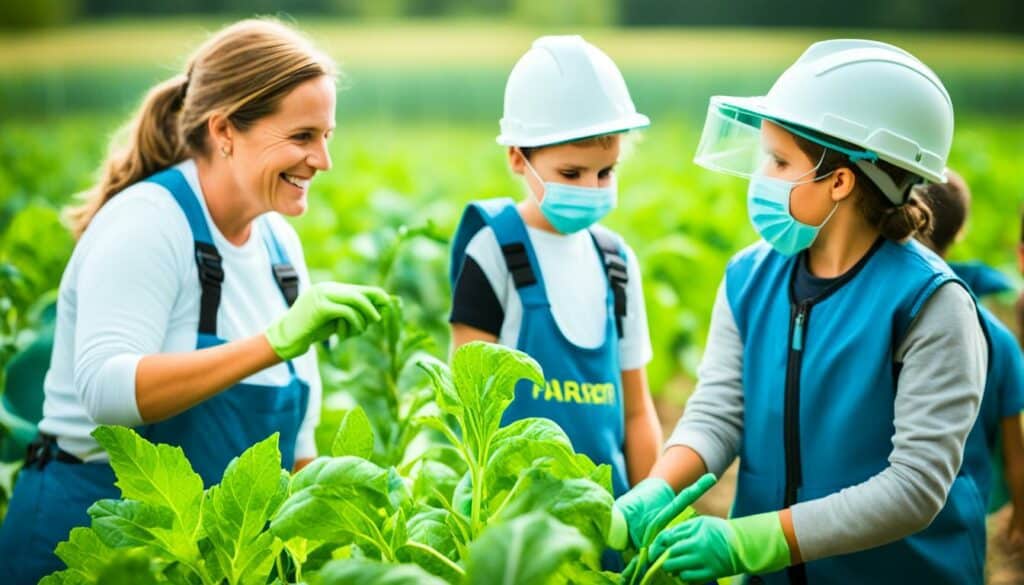
It’s key to have safe play zones away from danger areas on the farm. Putting up safety fences around places like ponds cuts the chance of accidents. Posting farm safety tips online can help kids learn about the dangers and keep safe.
Creating safe play zones for kids is about more than just blocking off an area. It needs parents and farm workers to always keep an eye out. Watching kids and making sure they stay in the safe zones is essential to avoid harm.
This is critical to fight children’s farm safety risks.
Setting solid safety rules is crucial for a safe farm. Kids must have adults near when around animals or machines. Teaching kids to always think of safety is key. It’s great to reward kids who follow the safety rules. This makes them more likely to keep being careful.
About 20% of farm deaths involve kids and teens. Each year, farms see about 27,000 kids badly hurt. This shows how important it is to watch them closely. Having clear rules and teaching kids about safety makes a big difference. It helps keep children safe on farms.
Fatigue in the harvest season is a big problem. It leads to more accidents like falls and blunt trauma. So, it’s key to fight fatigue to keep everyone safe and working well. Getting enough rest and planning breaks are smart ways to do this.
Getting good sleep is crucial to stay sharp during long farm hours. Safety advice says sleep should be a top priority. This helps cut down on injuries and keeps people from taking risky, tired decisions. It’s not just about feeling good but also creates a safer space for all.
Taking regular short breaks fights tiredness well. It helps keep energy up and minds clear. Adding these breaks to your day stops you from getting too tired, which can cause accidents. Drinking water and not having too much coffee are also key parts of staying on top of fatigue.
Keeping farming equipment visible is key for farm safety. Updated lighting and marking rules are important. These changes were made in November 2015 to improve safety compliance. Now, farmers must update their machinery’s lighting and markings to meet the latest standards. This is very important since accidents involving machinery are the main cause of harm on farms.
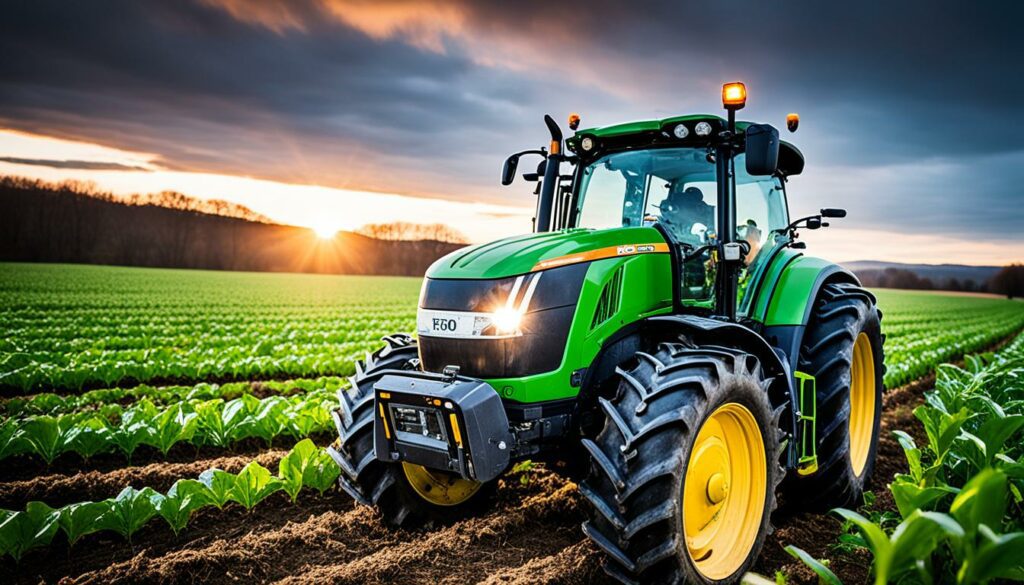
Following the right safety rules for lighting and marking keeps workers safe and helps the farm run smoothly. It’s a good idea to check your machinery often to make sure all reflectors and lights are in good condition. The American Society of Agricultural and Biological Engineers (ASABE) introduced new Slow Moving Vehicle (SMV) emblems. These new emblems have materials that light up from a mile away. The old ones could only be seen from a few hundred feet.
Where you put the SMV emblem matters a lot, according to the new lighting standards. Instructions say it should go on the rear centre or left rear of the machine, 2-10 feet above the ground. Putting it in the right place and keeping it clean makes sure it can be seen well. This is especially important at times when it’s hard to see, like at dawn or at night.
Using reflective tape and making sure the lights work are also vital. Farm machinery must be easy to spot, meeting the guidelines set by the American Society of Agricultural and Biological Engineers (ASABE). Not only does this follow the law, but it also cuts down the chance of accidents on the road. Farm vehicles often travel slowly, under 25 mph, on public roads.
| Requirement | Details |
|---|---|
| Implementation Date | November 2015 |
| SMV Emblem Visibility | Retroreflective materials detected from a mile away |
| Positioning | Rear centre or left rear, 2-10 feet above ground |
| Reflective Tape and Lights | Required as per ASABE guidelines |
| Agricultural Equipment Speed | Typically |
Keeping things safe in a grain bin is crucial for a safe harvesting season. It’s key to follow safety steps and always be aware of the dangers. This ensures grain storage is done correctly.
Handling grain safely is top priority to cut down on dangers. Getting stuck in moving grain is very risky and can happen fast. This risk is higher when the top layer of grain breaks, making a trap underneath.
When going into a grain bin, make sure all moving machines are off and locked. Also, wearing the right gear like a harness and using a lifeline is necessary. It protects your body if anything goes wrong. Having someone with you is a good idea too.
Knowing the risks around grain storage can stop accidents. Suffocation from compacted or wet grain can be deadly. Breaking up the top layer with a pole first can save lives.
Being covered by falling grain is dangerous; it can stop you moving. A rescue tool like a tube helps to get someone out. Make sure to check the air for bad gases. This keeps the inside of the grain bin safe too.
| Safety Measure | Description |
|---|---|
| Turn off and lock out equipment | Ensure all grain-moving equipment is deactivated before entering the bin. |
| Use a full-body harness | Utilise a secure harness with a lifeline to prevent entrapment. |
| Break crusted grain from outside | Employ an extendable pole with a small saw to handle crusted grain safely. |
| Install air monitors | Use monitors to check for harmful gases, ensuring safe air quality inside the bin. |
| Rescue equipment | Have tubes and other equipment ready to dig grain out in case of entrapment. |
| Always have an additional person present | Ensure another individual is present whenever working around a grain bin. |
Acting fast is key if someone is trapped in grain. Consider them alive and start rescue efforts at once. This includes cutting holes in the sides and using fans. By sticking to safe practices, you cut the risks when dealing with grain.
Machinery entanglements cause many farming injuries and even deaths. It’s crucial for everyone to prevent these by using safety steps. Properly fixed and looked-after machinery guards are key to lower the risk. They act like a strong wall against accidents. Covering all moving parts well is very important for machinery safety.
It’s vital for all machinery to have the right guards. These shields stop people from getting caught in moving parts. Check guards often to make sure they work right. Make sure machinery can’t turn on by accident when being fixed.
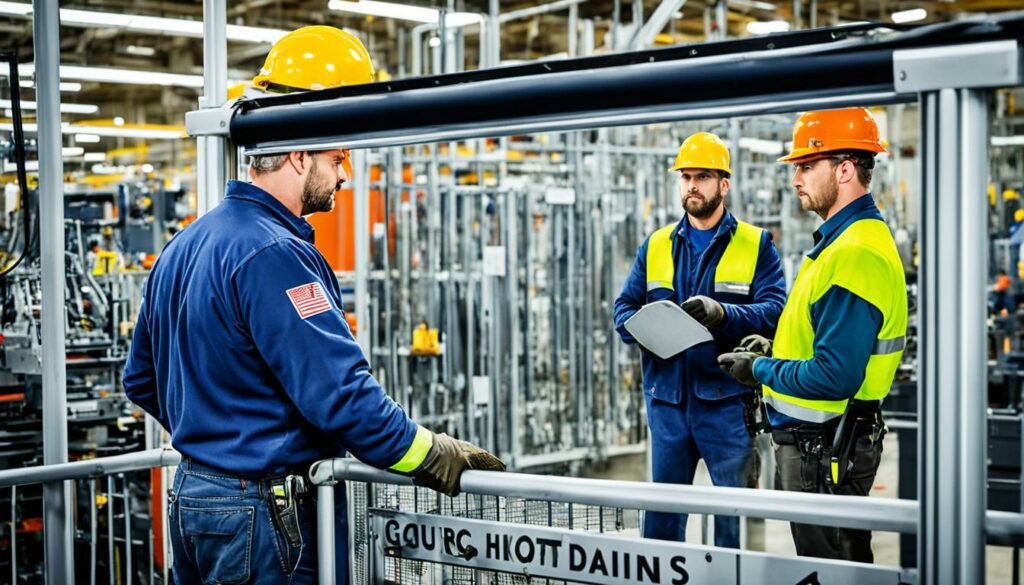
Children and others should stay far away from working machines. Clear rules and areas marked as ‘no-go’ help prevent problems. Teaching farm workers to stick to these rules adds a big safety layer. Tiredness and lack of training make dangers worse. So, only well-trained and sharp-eyed people should handle machines.
| Safety Measure | Importance |
|---|---|
| Regular Maintenance of Machinery Guards | Prevents moving parts entanglement |
| Lockout Tagout Procedures | Prevents accidental activation during repairs |
| Designating No-Go Zones | Keeps bystanders and children safe |
| Ensuring Proper Training | Minimises risks from inexperienced operators |
| Maintaining Alertness | Reduces incidents caused by fatigue |
Stopping entanglement accidents mixes proper care, strict rules, and always being on the lookout. With good training and watchful eyes, farms become much safer. It’s a must for every farm to put safety first, to protect all its workers.
As the fall harvest nears, keeping safe is extremely important. We must drink enough water and eat well. Wearing the right gear also helps us avoid big risks and have a good harvest.
Getting enough water is key during the fall harvest. It helps us stay focused and perform better. Eating right is just as crucial. It keeps us strong for the hard work. Not getting enough sugar in our blood means our energy drops and we may not work safely.
Protective gear like gloves and safety glasses is a must around machinery and chemicals. This gear keeps us safe. Checking that all machine shields are in place helps avoid accidents too. PPE reminds us to be safe daily.
When bad weather hits, we need to check fields for extra metal or trash. Use good tow ropes, not chains, to avoid incidents when pulling equipment. Following lockout/tagout rules makes sure no one gets hurt fixing machines.
Farm safety is all about being alert and taking steps to stay safe. Always check for hot spots in hay, honk three times before turning on machinery. Put up rollbars to protect against rollovers. Doing these things well can help us steer clear of harm and enjoy a good harvest time.
| Safety Measure | Description |
|---|---|
| Hydration | Drink adequate water to maintain alertness and physical performance. |
| Nutritional Needs | Maintain a balanced diet to meet the strenuous demands of harvesting. |
| Protective Gear | Use gloves, safety glasses, and respirators when handling machinery or chemicals. |
| Safety Practices | Follow PTO shaft inspection, horn honking, and debris clearance protocols. |
| Emergency Protocols | Implement LOTO guidelines and utilise tow ropes instead of chains. |
Keeping agricultural transportation safety top of mind is crucial, especially when moving between fields. Shocking stats show that 368 farmers and farm workers died from job injuries in 2020. Transportation accidents were the main reason. So, it’s vital to be very careful when moving stuff around.
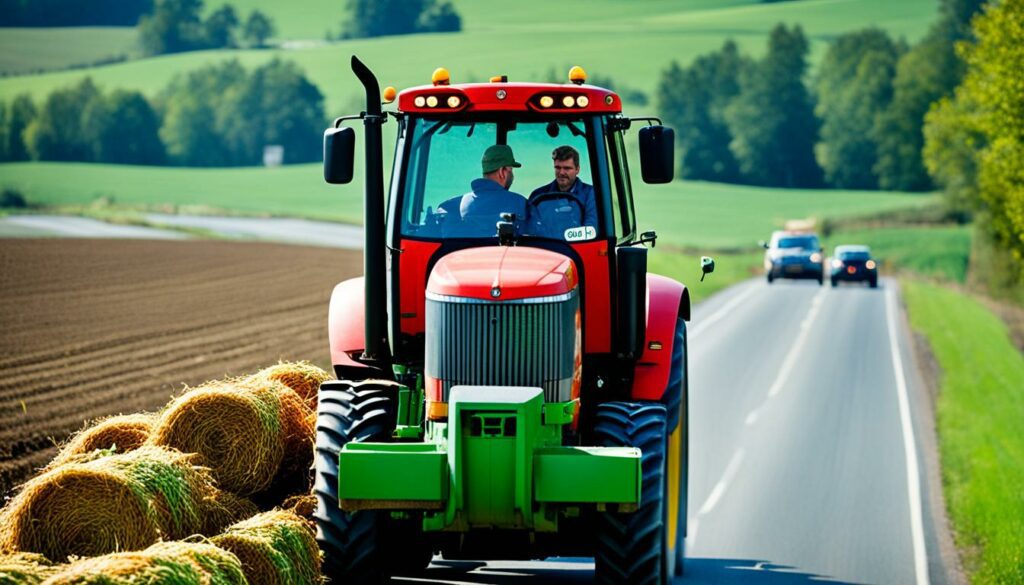
First off, it’s key to know farm gear moves at 15 to 25 mph. Compare this to a car at 55 mph. It can close a gap the size of a football field to a slow tractor in just five seconds.
So, we need to do a few things to keep safe, like sticking on reflective tape, not losing focus, and making sure what we’re moving is put on right and won’t fall off.
Escort vehicles are a big help on tight roads. Since more cars are using country lanes, these guides are important. They help keep large or slow farm machines safe and not cause danger to others.
Then, there are SMV signs for vehicles going less than 25 mph. These orange triangles make it easy for others to see farm stuff. Staying off busy roads or going when there are fewer cars also cuts down risks.
The CDC says, always check that safety items like guards are in good shape. And don’t forget about gear that protects your eyes and ears. They can make a big difference in agricultural transportation safety.
“Farm safety means looking at road rules, using gear right, and having plans for quick help. Doing these things keeps farm teams and the community safe.”
By using smart ways in rural traffic navigation and when to add escort vehicles, we can make moving farm equipment safer. These steps really help cut down on wounds and deaths in farming.
On farms today, knowing how to use a tourniquet is very important. It’s a skill that can save lives. More than 20,000 tourniquets are used daily worldwide, for surgeries and in emergencies.
Having a first aid kit with a tourniquet is crucial. It can be the difference in emergencies like severe limb bleeding. Studies suggest not using a tourniquet for more than 60-90 minutes to keep things safe.
The Route 91 Harvest Music Festival shooting shows how important life-saving actions are. Among 413 people who survived gunshot wounds, fast tourniquet use was key.
New studies are helping us understand tourniquet use better. They found that special treatments can limit harm during long use. These findings help make tourniquet use safer.
It’s vital to know how to use a tourniquet. Hands-on training programs like Stop the Bleed can help. They boost confidence and skills in using life-saving methods.
It’s key for people on farms to be ready for emergencies. Knowing first aid well can help manage accidents or unexpected disasters. This keeps people safer on the farm.
Keeping farms safe and running well relies on servicing our equipment and regular safety checks. It’s key to follow the maker’s advice and check guards fully. This makes farm work smooth and safe.
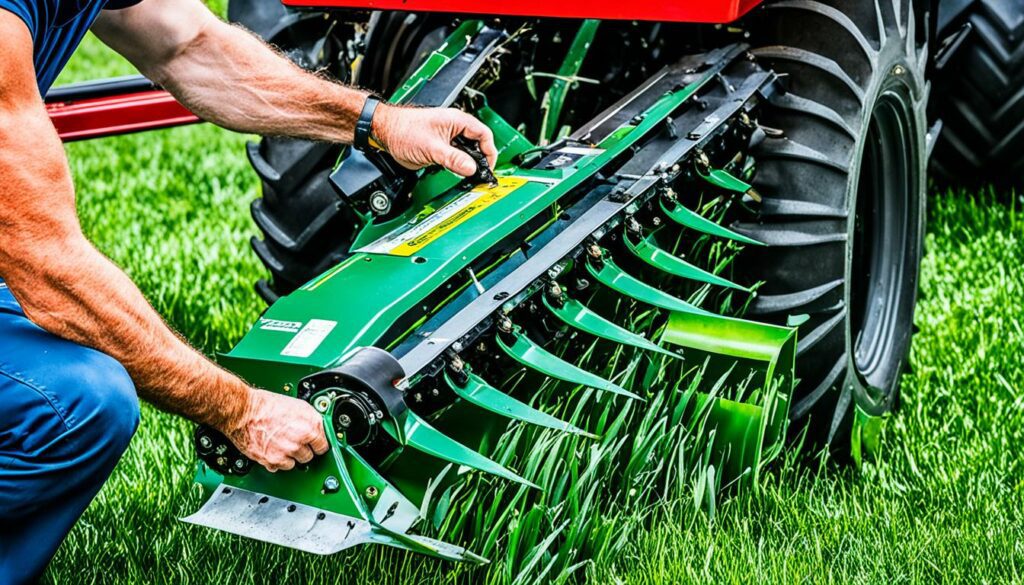
To keep machinery running well, following the manufacturer’s advice is critical. Changing the oil regularly keeps the engine smooth. Also, make sure to grease moving parts to prevent damage and breakdowns.
Checking a machine’s guards is crucial to avoid injuries like getting caught. Making sure all guards are on keeps workers safe. Regular safety checks spot any problems with guards and fix them.
With these steps, farm machinery can be relied upon to be safe and work well. This ensures a secure workplace and makes equipment last longer.
The global population is set to hit almost ten billion by 2050. This makes a 70% increase in food needed. Currently, over a billion people work in farming. Sustainable agriculture methods are key in boosting food output without harming the environment. They use nearby resources, cut down on water use, and use natural fertilisers. This keeps the soil healthy and decreases how much it wears away.
Using sustainable ways means more food that’s good for you and uses less of our vital land. It helps build stronger local places and more jobs for small farmers. This lets them grow more food using less.
Mixing sustainable agriculture with old-style farming keeps things green. It makes sure everyone can buy food, no matter how much money they have. Also, planting different crops in the same fields at different times or together helps the soil and keeps pests away.
| Practices | Benefits |
|---|---|
| Cover Crops | Prevent erosion, replenish soil nutrients, reduce the need for fertilisers |
| No-till or Reduced-till | Reduce erosion, enhance soil health |
| Integrated Pest Management (IPM) | Reduce reliance on chemical pesticides |
| Agroforestry | Provide shelter, protection, and additional income from fruit or nut crops |
Sustainable farming puts the environment first and builds a healthier farming way. Places that manage whole landscapes see less soil wearing away and fewer nutrients get washed away. They also help bees and other animals to live. Good soil is vital for strong plants, holding water, stopping pollution, and making farming last.
Doing farming right means we can feed everyone now and look after our world for the future. Sustainable ways mix a green planet, making money, and being fair for all. They ensure our crops are safe and that farming is a good way of life.
Using safe harvesting techniques is vital. It keeps workers safe. It also helps ensure we can keep farming without harming the land. This way of working mixes old and new methods in farming.
For years, people have used traditional ways to gather crops. They rely on people’s hands and basic tools. Now, even with big machines around, these ways are still important. Checking machine parts, like the PTO safety shields, often stops big accidents.
Farmers find these ways of working good for many reasons. They can harvest crops safely. Also, they can make sure they are working in a way that respects the world around them.
When it comes to organic farming, how we treat our crops matters. We use gentle picking and safe stuff to keep crops healthy. Also, keeping our tools clean and bright helps everyone see better and avoid accidents. Using organic methods shows we care about lasting farming practices.
Using old ways with new ideas can make farming even better. It helps crops grow more and people work more safely. For example, before turning on the machines, a quick horn signal can warn others and keep everyone safe.
Mental health in the agricultural and farming community is a growing concern. Seeking help when necessary is crucial to maintaining overall well-being during the demanding harvest season.
| Safety Measure | Importance |
|---|---|
| Cleaning safety reflectors, lights, and mirrors | Ensures visibility and prevents accidents |
| Inspecting PTO safety shields | Prevents severe injuries each season |
| Removing plugs from a combine’s corn head safely | Outlines safe procedure during field operations |
| Honing the horn three times before starting machinery | Alerts crew members of movement and potential hazards |
| Checking tow ropes and chains | Ensures safe pulling of stuck equipment |
Joining old and new ways of harvesting is still vital today. It highlights the importance of working safely and wisely. This mix is key to a better, safer farming future.
For more advice on safe harvesting, check out Safe Harvest Season Guidelines.
When we look at safe ways to harvest, we see many good things come from it. For example, less people get hurt, and more crops get collected. About 40% of food that can spoil gets wasted after it’s picked. This shows us how important it is to be careful and organized after the harvest.
To have a harvest without problems, you need a plan before you start. It’s also very important to keep your tools and equipment in good shape. People who help during the harvest work hard. We must make sure they’re not too tired, as this can lead to mistakes or accidents. They should take breaks and rest enough to stay sharp.
My point of view is that using old and new methods together can make a harvest do well. Taking care when picking fruits and vegetables, cooling them fast after picking, and wearing the right clothes all help keep the food good. This is what a good safety plan looks like. Making sure everyone knows how to stay safe and controlling where vehicles go are also key parts of keeping the harvest going smoothly.
All in all, when we use these tips together, we get a complete and safe plan for harvesting. Not only does this protect the workers, but it also means we get more and better food. This is what makes a harvest season a success, without anyone getting hurt.
Safe harvesting requires proper training and planning. It involves keeping equipment well-maintained. Using protective gear and being hydrated and well-fed are key. These steps lower risks and improve how crops are managed.
Pre-planning is vital. It includes making checklists and maintaining equipment. This preparation stops machinery from breaking down. It also makes sure everyone is safe and work runs smoothly.
Reading equipment manuals makes the workplace safer. It helps workers know how to use machines correctly. This knowledge is critical for running farms safely.
An emergency plan should have contact details and clear directions. It’s important to know where everyone is. This ensures quick and useful actions during any emergency.
To keep yards safe, cut low tree branches and fix electrical issues. Looking after the yard well cuts risks. It makes the work area safe for everyone.
Training is crucial for knowing how to use machinery safely. It prevents accidents and makes sure farm machines are used properly.
Make sure kids play away from machinery and follow safety rules. It’s vital to always know where they are. This keeps children safe on the farm.
To beat tiredness, sleep well, take breaks, and eat healthily. Avoid too much caffeine. These steps help you stay sharp and avoid risky shortcuts.
Farm vehicles need good lights and markings to be seen in bad light. These rules, updated in November 2015, prevent accidents. They help in early mornings, late evenings, and at night.
Knowing how to handle grain and spotting dangers is key. Following safety advice makes a harvest safe and successful.
To avoid getting caught in machinery, cover moving parts and keep people away. Being organised and alert helps prevent accidents.
To stay safe, drink water, eat well, and wear the right protective gear. Follow safety steps when using machines. These tips stop injuries and keep work safe.
Make sure to drive safely, use escort vehicles, and watch out for more traffic on small roads. Planning the best routes protects everyone when moving between fields.
Having a tourniquet in a first aid kit is vital. It stops severe bleeding, which can be fatal. Knowing how to use a tourniquet is a must for emergencies.
It means following the maker’s service advice and keeping machine guards in place. Regular safety checks make machines and work areas safer.
Sustainable farming is key for a safe harvest. It looks after the soil, the environment, and follows ethical practices. It makes farming safer for everyone involved.
Old methods and organic farming are safe ways to grow crops. They protect workers and the environment. These are important for a safe and lasting harvest.